Top>Education>Educational Trip to Sakhalin (Karafuto)
 Index
Index
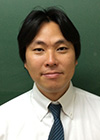
Atsushi Yamada [profile]
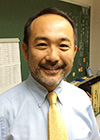
Akinori Kikuchi [profile]
Educational Trip to Sakhalin (Karafuto)
Akinori Kikuchi
Teacher of Japanese Language (specializes in Modern Literature (Japanese Poetry))
Chuo University Suginami High School
Atsushi Yamada
Teacher of Geography and History (specializes in Modern German Social History)
Chuo University Suginami High School
Change from school trips to study tours
Chuo University Suginami High School is an affiliated school of Chuo University. More than 90% of our students enter Chuo University. Fortunately, our students are able to spend their 3 years of high school without being absorbed with studies for entrance examinations. This also means that teachers are free to conduct education without the constraint of studying for entrance examinations. Within this blessed educational environment, teachers constantly consider what kind of education to provide, what can be accomplished and what must be addressed.
School trips hold an extremely special significance within school events. Some people say that, historically speaking, the role of school trips is no longer important. However, it is safe to say that today’s high school students look forward to their school trip more than any other events during the 3 years of high school.
Since 2003, Chuo University Suginami High School has changed the name of school trip to study tour. This change reflects our intention of emphasizing the learning opportunity offered by such trips. We also place importance on learning to prepare for and review the trips. In 2008, we offered 5 study tours to Hokkaido. As reported, one of those trips was To Sakhalin (Karafuto), the first such trip since World War II.
Providing high-quality educational stimuli
Teachers at Suginami High School seek to provide high-quality educational stimuli. Most importantly, we want to give students the opportunity to think independently.
On our study tours, students do not pursue a predefined answer. Instead, trips are planned to allow each student to think independently. In today’s world, people are easily influenced by the chaos of reality in which we live. For young people who will lead society in the next generation, it is essential to form a thorough understanding of such people and the society in which we live.
We want our students to recognize the importance of obtaining a first-hand experience, of thinking independently, and of expressing opinions in one’s own words. Sakhalin (Karafuto) provided outstanding stimuli.
No preliminary knowledge
As expected, students had almost no preliminary knowledge regarding Sakhalin (Karafuto). Neither did teachers.
The origins of this trip itinerary can be traced back to when students were checking a map and asked why southern Sakhalin is referred to as being white washed.
“Russia is the adjacent country to Japan. It’s part of Europe.”
“Should we call the region Karafuto Prefecture?” asked students. “Or is it called Sakhalin?”
“Okinawa was not the only place in Japan where ground fighting took place,” I told them. “Battles also took place in the urban areas of Karafuto Prefecture. Also, these battles took place after the end of the war. Why does everyone know about Okinawa but no one knows about Karafuto? 400 thousand people lived there.”
Students were surrounded with new information and unlearned facts.
Eventually, students formed a vague understanding that while Sakhalin is the closest European region to Japan, it cannot be called Russian territory from Japan’s perspective. They also learned that the Japanese Consulate General is stationed in Sakhalin, and that a sad and regrettable battle took place on the island.
“Why don’t you visit Sakhalin (Karafuto) for a first-hand experience?” urged teachers “This may be your only chance to learn about the citizens who have been pushed around by history and the feelings of people living in Sakhalin (Karafuto) today. Let’s take a trip together to learn about these different perspectives!”
“One more thing,” I said with the provocative grin and sinister tone of voice which is unique to high school teachers. “You are going to have to search for yourselves!”
Preliminary learning
From 18 months before the trip, we prepared a variety of preliminary learning activities for students.
First, I had students watch the NHK television program Project X: Rescue Beyond Borders—Saving the Life of Konstantin, A Young Boy with Severe Burns. Relay of the Life. This documentary told the story of a boy who was rescued through extra legal measures in 1990. The program was a shock to students who weren’t familiar with the Soviet Union.
I also gave students an assignment based on the film Karafuto 1945 Natsu Hyosetsu-no-Mon (Karafuto, Summer 1945: Gate of Ice and Snow). This film has a complicated past; its showing was prohibited immediately before its scheduled release. When I conveyed the straightforward questions of students to the Screening Committee, the film’s assistant director Mr. Taku Shinjo visited our school to speak with students. It was a wonderful and unexpected opportunity to hold a special class.
Moreover, students enjoyed a special lecture given by Professor Fujio Mizuoka (Hitotsubashi University Graduate School), who volunteered to speak in front of our students. Professor Mizuoka has the experience of leading university students on a tour of Sakhalin.
We also had the opportunity to hear that a married couple tell their story of being born in Karafuto Prefecture, getting married in Karafuto following WWII, and then leaving their homeland. In this way, the rich preliminary learning of students was supported by many individuals.
Preliminary learning also took place for other trip itineraries. A group of students planning to visit Nemuro and learn about the Northern Territories received a video letter from Mr. Fumio Kishida, Minister of State for Okinawa and Northern Territories Affairs (position at that time; currently Minister of Foreign Affairs). At that time, student planning to visit Sakhalin (Karafuto) were starting procedures to obtain a Russian visa. Students learned that the Northern Territories are depicted on the flag of Sakhalin Oblast and that obtaining a visa would allow them to travel to Kunashiri Island and Iturup Island in the Northern Territories. As preliminary learning proceeded for each itinerary, the learning contents were naturally connected, thus creating a meaningful learning experience for students in all itineraries.
Crossing the ocean
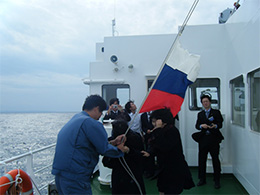
Students hoist the Russian flag on the ferry
First, I must write about how wonderful it is to travel to foreign countries by ship. Each traveler is engrossed in his or her own imagination of how ancient people must have gazed upon the broad ocean. It is a special experience which cannot be obtained through any other mode of transportation. Also, a 5-and-a-half hour trip is the perfect amount of time to spend on a ship. A school of dolphins swam next to the ship, their backs gleaming in the deep-blue water. The students’ eyes were gleaming with excitement and curiosity. It was a clear reminder of how a change in atmosphere can contribute to growth in students.
Speaking with local people
We created opportunities for students to speak with numerous individuals of different nationalities. For example, Japanese businesspeople seeking to expand business on Sakhalin, the Consulate General of Japan stationed in Yuzhno-Sakhalinsk, Korean who have lived in the region since the Karafuto Prefecture period, and Russians who continue to finance their own trips to gather the remains of their ancestors. Making the most of this precious opportunity, students listened attentively to stories told by these people.
An eye-witness view
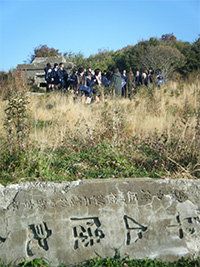
The fallen memorial to the landing of the Japanese army
Upon disembarking from the ferry, students were greeted by a fascinating townscape which combined things from both Japanese and Russian. Although the station plaza had a Japanese-like atmosphere, a giant statue of Lenin stood nearby. It was a unique atmosphere woven by the history of the town.
When climbing a hill overlooking Aniva Bay, students were greeted by a crumbled memorial dedicated to the landing of the Japanese army. The vast blue ocean stretches out below. In distance, one can see the giant plant for LNG which is part of the Sakhalin 2 Project. The discarded pillboxes of Japanese soldiers lie at our feet. The farm fields spanning the hills are scattered with the vacation homes of a Russian ethnic group known as Dacha, showing the lifestyle of local people. From this hill, one can gaze over the past, present and future of Sakhalin (Karafuto). Immediately adjacent to the town lifestyle is the site of new and old national projects.
Next, students visited Kumasasa Pass, this site of fierce battles between Japan and Russia. Although we had been blessed with sunny skies until then, it suddenly became cloudy. We were enveloped by a chilly fog and the wind began to blow in gusts. While shivering in this unexpected cold, students thought of the countless people who had lost their lives in this very spot.
At Maoka (Kholmsk) Town memorial which is known for the death of nine maidens, students offered flowers and prayed silently, contemplating the events which happened here. I wonder what students felt upon seeing the innocent smile of a young Russian girl who had been gazing with fascination upon the actions of Japanese students dressed in school uniforms.
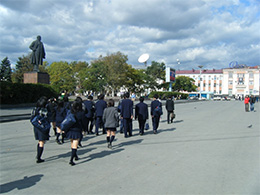
Statue of Lenin in the plaza in front of Yuzhno-Sakhalinsk Station
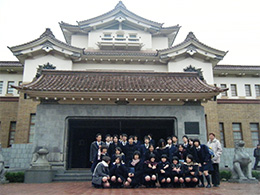
Sakhalin Regional Museum (formerly the Karafuto Prefecture Museum)
Food culture
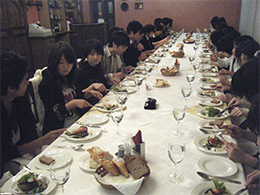
Dinner on the first night of the trip. Students relish the authentic Russian cuisine.
Upon entering their first restaurant in Sakhalin, students were greeted at the entrance by a Russian woman holding a large loaf of bread and salt. It is customary for diners to tear off a bite-sized piece of bread, sprinkle it with salt and eat it. After slight hesitation, students happily enjoyed bites of the bread. During our visit, no matter what restaurant we ate at, we enjoyed courses of warm Russian cuisine in relaxed atmosphere. Such leisurely dining would be unheard of for a normal Japanese school trip, but such are the customs in Russia.
No matter where we visited, no one was selling soft serve ice cream or other snacks. There was nowhere to purchase and eat small meals, and there were no snacks to eat on the bus. As a result, students looked forward to their 3 daily meals with great anticipation. Such dining experiences allowed students to naturally understand the food culture of Sakhalin.
Group exchange
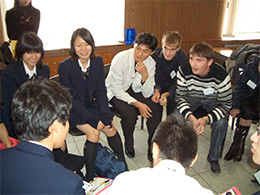
Group exchange held with Russian students
We also held a group exchange together with students at the Yuzhno-Sakhalinsk Institute of Economics, Law and Informatics. My worries that students would be nervous were soon proved unfounded. All of the groups were engaged in lively conversation. Japanese students were able to directly experience the feelings and opinions of Russians in the same age group. They exchanged email addresses and took photographs together. It was extremely interesting to watch students communicate in a mixture of Japanese, Russian and English. The group exchange was a meaningful experience for everyone involved.
Reflection

Study tour file made by students
When returning to Japan, we visited Hyosetsu-no-Mon (Gate of Ice and Snow) again in Wakkanai City. There was great significance in ending our study tour at this site. In the distant, we could see Sakhalin (Karafuto) which we had just visited. Many students hung their heads deeply at the sight.
“We should have learned more before we came.”—I heard this sentiment expressed by more than a few students.
After returning to Japan, students composed a file of their study tour. They created sheets by writing comments and affixing photographs, tickets and memorable pieces of paper. Our students are skilled at such work and created a research file filled with their thoughts and emotions.
A bronze statue of Taiho Koki
In August, a small newspaper article related how a bronze statue of the famous yokozuna (sumo Grand Champion) Taiho Koki had been erected in his birthplace of Shikuka (Poronaysk). An unveiling ceremony had been held on August 15th. I was surprised to learn that the statue had been proposed by the mayor of Poronaisk Also, I wondered how this news would be received by Suginami High School graduates who had participated in the study tour to Sakhalin (Karafuto). I want to believe that students were affected by an article which was so small and easy to overlook. It would bring me great pleasure if our study tour had a lasting effect on each of the students. Such thoughts ran through my head as I gazed at the newspaper. I began to dream of someday taking students to see the statue of Taiho Koki.
A record of this study tour has been added as a book in the Chuo University 125 Library. I hope that many people will read this record and provide opinions on our study tour as an educational practice.
- Akinori Kikuchi
Teacher of Japanese Language (specializes in Modern Literature (Japanese Poetry))
Chuo University Suginami High School -
He was born in Saitama Prefecture in 1963. He graduated from Chuo University High School. He graduated from the Department of Literature at the Chuo University Faculty of Letters with a major in Japanese literature. He completed the Master’s Program and dropped out the Doctoral Program at Chuo University Graduate School. In 1991, he was appointed as a Full-Time Instructor of Japanese language and literature at the Department of Foreign Language, Hyosung Women’s University (Korean). He assumed his current position in 1993. He has a certification as a disaster-prevention expert. He has been involved with Chuo University affiliated high schools for more than 20 years. He serves as an advisor to the Rakugo Research Club.
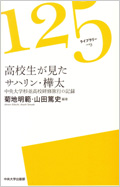
Sakhalin (Karafuto) Through the Eyes of High School Students
―A file of the study tour by Chuo University Suginami High School
His written works include Notes of One-Hundred Ogura Poems (co-written; Katsura Bookstore), Eiyo Poetry Collection: Volume I and II (co-written; Koten Bunko), and New Standard Japanese Language Curriculum: Intermediate, Volume I and II (co-written; Dalian Publishing) - Atsushi Yamada
Teacher of Geography and History (specializes in Modern German Social History)
Chuo University Suginami High School - He was Born in Aichi Prefecture in 1976. He graduated from the Faculty of Social Science at Hitotsubashi University. He completed the Master’s Program and dropped out the Doctoral Program at the Hitotsubashi University Graduate School of Social Science. He assumed his current position in 2004. He teaches mainly world history. His area of expertise is Modern German Social History. He developed an interest in Russian history and culture after being instructed by a teacher who specialized in Russian history. During an advance visit for the study tour, he traveled beyond the northern latitude of 50 degrees on Sakhalin (Karafuto).
- Research Activities as a Member of Research Fellowship for Young Scientists (DC1), Japan Society for the Promotion of Science (JSPS) Shuma Tsurumi
- Important Factors for Innovation in Payment Services Nobuhiko Sugiura
- Beyond the Concepts of Fellow Citizens and Foreigners— To Achieve SDGs Goal 10 “Reduce Inequality Within and Among Countries” Rika Lee
- Diary of Struggles in Cambodia Fumie Fukuoka
- How Can We Measure Learning Ability?
—Analysis of a Competency Self-Assessment Questionnaire— Yu Saito / Yoko Neha - The Making of the Movie Kirakira Megane








